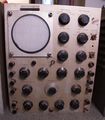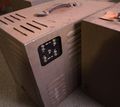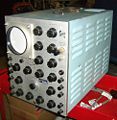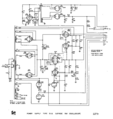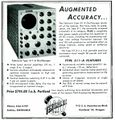511: Difference between revisions
(cat) |
No edit summary |
||
| (52 intermediate revisions by 4 users not shown) | |||
| Line 1: | Line 1: | ||
{{Oscilloscope Sidebar | | {{Oscilloscope Sidebar TEST | ||
|manufacturer=Tektronix | |||
summary=10 MHz Tube scope<br />''First Tektronix | |series= | ||
image=Tek | |model=511 | ||
caption=Tektronix 511 front | | |summary=10 MHz Tube scope<br />''First Tektronix oscilloscope'' | ||
introduced=1947 | | |image=Tek 511 1.jpg | ||
discontinued=1953 | | |caption=Tektronix 511 front | ||
manuals= | |introduced=1947 | ||
* [ | |discontinued=1953 | ||
* [ | |designers=Frank Hood;Logan Belleville;Howard Vollum | ||
* [ | |manuals= | ||
* [ | * [[Media:IM-511.pdf|Tektronix 511/511A Manual]] (OCR, includes S/N 5100+ information) | ||
* [[Media:IM-511A-1.pdf|Tektronix 511A Manual SN <2869]] (OCR) | |||
* [[Media:IM-511A-2.pdf|Tektronix 511A Manual revised in 1951 for SN 2869-5099]] (OCR) | |||
* [[Media:1947_Tektronix_Catalog.pdf|Tektronix 1947 "Catalog" (511 only)]] | |||
}} | |||
The 511 was Tektronix' '''first oscilloscope''', [[introduced in 1947|introduced in June 1947]] but only the second product released by the young company – the first was the [[101|Type 101 Video Calibrator]]. | |||
[[Howard Vollum]] was directly involved with the design of the 511. | |||
__TOC__ | |||
According to TekWeek March 23, 1984, ''"511" stood for 5-inch tube, 1 channel, 1st model. It sold for $795<sup>[Note 1]</sup>, compared to $1,800 for a two-piece Dumont scope that was mostly pre-war technology.'' | |||
An improved version, the 511A, was [[introduced in 1948|introduced in November 1948]]. Major improvements included a regulated power supply for CRT, and a (in later models, s.b.) a calibrator. The 511AD was available through 1953. | |||
{{BeginSpecs}} | |||
{{Spec | Bandwidth | 5 Hz to 10 MHz (8 MHz with 2-stage amplifier); no DC coupling }} | |||
{{Spec | Rise time | 40 ns (50 ns with 2-stage amplifier) }} | |||
{{Spec | Deflection | Without amplifier, 27 V/cm – 200 V/cm, DC or AC<sub>p-p</sub>. 1-stage amplifier, 2.7 V/cm – 40 V/cm. 2-stage amplifier, 0.27 V/cm – 4 V/cm. }} | |||
{{Spec | Input | 1 MΩ // 40 pF; 600 V max. DC+peak AC }} | |||
{{Spec | Sweep | 100 ns/cm to 10 ms/cm + variable; ×5 magnifier }} | |||
{{Spec | Trigger | 0.5 to 50 V (Peak) sine or pulse ≥50 ns }} | |||
{{Spec | X input | DC coupled via 100 K potentiometer and sweep amplifier; 1.5 V/cm or less; DC to 800 kHz }} | |||
{{Spec | CRT | [[5CP]], 3 kV acceleration }} | |||
{{Spec | Calibrator | Clipped sine wave of power line frequency, ranges 0-0.3, 0-1, 0-3, 0-10, 0-30, 0-100 V<sub>p-p</sub> }} | |||
{{Spec | Outputs | Sweep sawtooth, 20 V<sub>p-p</sub>; Positive and negative gate, 40 V<sub>p-p</sub> }} | |||
{{Spec | Weight | 511 – 29 kg (65 lb); 511A – 23 kg (50 lb); }} | |||
{{Spec | Dimensions | 15½" high, 12½" wide, 21½" deep }} | |||
{{Spec | Power | 511 – 180 W; 511A – 105-125 or 210-250 V, 50-60 Hz, 230 W }} | |||
{{EndSpecs}} | |||
(511A unless noted otherwise) | |||
There is also a 511AD, where the "D" in the model number indicates that it has an L-C [[delay line]]. | |||
== | ==Prices== | ||
* $795 in 1948 (~$9,700 in 2023 dollars) | |||
==Internals== | ==Internals== | ||
The 511 uses a standard CRT, the [[5CP1A]] | The 511/511A uses a standard CRT, the [[5CP1A]] (with P1 [[phosphor]]), [[5CP7A]] ([[phosphor|P7]]) or [[5CP11A]] ([[phosphor|P11]]) below S/N 5100, the [[5AB]]P from 5100 up. P1 was standard, P7 and P11 optional at no extra charge. | ||
The vertical output is a pair of [[6AG7]] tubes, AC-coupled to the vertical deflection plates. The horizontal amplifier is DC-coupled through a chain of five [[NE-2]] neons on either side for voltage offset. | |||
There was an option that added a 1 μs marker generator. | |||
Neither the 511 nor the 511A has a [[thermal cutoff]]. | |||
The 511 | ===511=== | ||
The original 511 was produced with serial numbers 101 to 454 (June 1947 – November 1948). | |||
The | There are two power transformers, T1 and T2, both operating on 60 Hz mains power with their primaries in parallel. | ||
T1 produces the CRT anode and cathode voltages, as well as various other regulated and unregulated voltages. | |||
The CRT cathode and anode voltages (+1500/-1500 V) are simply rectified voltages from the secondary of T1. | |||
The lack of regulation means that variations in mains voltage results in variation of deflection sensitivity. | |||
The +275 V and + 475V rectifier circuits have choke inputs. | |||
===511A (SN 455+)=== | |||
The main difference introduced in the 511A is the power supply. | |||
The regulated positive supply voltages were lowered somewhat to +225 V and +450 V, with capacitor-input circuits (no chokes). | |||
The CRT cathode and anode voltages are produced by a 2 kHz oscillator (a [[6AQ5]]) that is powered by the +225 V<sub>DC</sub> regulated supply. | |||
This results in vertical deflection calibration that is independent of mains voltage. | |||
HV rectifiers are two [[1B3GT]] tubes producing +1500/-1500 V. | |||
===511A (SN 1406+)=== | |||
Beginning with SN 1406, the 511A(D) gained a continuously variable sweep speed control, visible as a 2nd dial next to the "sweep speed multiplier". | |||
===511A (SN 2406+)=== | |||
From SN 2406 upward, a dedicated calibrator stage uses one half of a [[12AT7]], V16.1, to clip a voltage derived from the mains transformer to a 100 V level divided from the regulated +225 V rail. | |||
The HV rectifier uses two [[1V2]] tubes producing +1800/-1500 V. | |||
===Delay=== | |||
The Tektronix Type 1-AD-25 delay line, composed of 24 L-C sections, was available as a factory option for the 511A. With the delay, the scope is a 511-AD. | |||
Even when ordered without the delay, the 511's chassis was pre-drilled for the delay so that it could be added later, in the field, without drilling. | |||
The delay could be switched in and out of the signal path, presumably to avoid the slight signal degradation the delay causes. | |||
==History== | ==History== | ||
The 511 was designed by [[Frank Hood]], [[Logan Belleville]], and [[Howard Vollum]]. | |||
* See also https://vintagetek.org/tektronix-first-products/ | |||
Tektronix engineer [[Frank Hood]] recollects: | Tektronix engineer [[Frank Hood]] recollects: | ||
<blockquote>My first assignment was to build or modify some special instruments for Bonneville Power. They wanted a device that would detect and record any lightning strikes or arc-overs on the high voltage power lines running between Vancouver, Wash. and other cities such as Longview, Spokane, etc. They wanted to detect each event, in a fraction of a millionth of a second, then to send a pulse of energy down the defective line and measure the time it took to return, (this was an application much like radar). They wanted markers displayed at each mile and fraction of a mile so that they could determine the exact location of the fault. They needed to record a photographic image for latter study. Two or more such instruments were built. We called these Type 511B. They worked very well and were used for several years. | <blockquote>My first assignment was to build or modify some special instruments for Bonneville Power. They wanted a device that would detect and record any lightning strikes or arc-overs on the high voltage power lines running between Vancouver, Wash. and other cities such as Longview, Spokane, etc. They wanted to detect each event, in a fraction of a millionth of a second, then to send a pulse of energy down the defective line and measure the time it took to return, (this was an application much like radar). They wanted markers displayed at each mile and fraction of a mile so that they could determine the exact location of the fault. They needed to record a photographic image for latter study. Two or more such instruments were built. We called these Type 511B. They worked very well and were used for several years. | ||
| Line 59: | Line 98: | ||
==Links== | ==Links== | ||
[ | * [https://richardsears.wordpress.com/2012/01/07/near-the-beginning-of-an-era-the-tektronix-511a/ Richard Sears' detailed 511A Page] | ||
* ''[Note 1]'' TekWeek March 23, 1984 says $595 but the advertised price was $795 (see below). | |||
==Pictures== | ==Pictures== | ||
===511=== | |||
<gallery> | |||
Tek 511 1.jpg | |||
Tek 511 2.jpg | |||
Tek 511 3.jpg | |||
Tek 511 4.jpg | |||
Vollum scope - Electronics Magazine April 1948.jpg | Vollum scope - Electronics Magazine, April 1948 | |||
Septad511.jpg|511 ad from September 1948 | |||
Tek 511 ps.png | 511 non-A power supply schematics | |||
</gallery> | |||
===511A=== | |||
<gallery> | <gallery> | ||
Tek 511a 1.JPG | |||
Tek 511a 2.JPG | |||
Tek 511a 3.JPG | |||
Tek 511a 4.JPG | |||
Tek 511a 5.JPG | |||
Tek 511AD top 2.jpg | |||
Tek 511AD top 3.jpg | |||
Tek 511AD bottom 2.jpg | |||
511a-ps.png|511A | |||
511a-vertical.png|511A | |||
511a sweep.png|511A | |||
511A ad from Electronics 1948-11 p239.jpg | 511A ad from Electronics Magazine, November 1948, p.239 | |||
</gallery> | </gallery> | ||
===511AD=== | |||
<gallery> | |||
Tek 511ad 1.jpg|511AD | |||
Tek 511ad 2.jpg|511AD | |||
Tek 511ad 3.jpg|511AD | |||
Tek 511_ad4.jpg|511AD | |||
</gallery> | |||
==Components== | |||
{{Parts|511}} | |||
{{Parts|511A}} | |||
[[Category:Monolithic tube scopes]] | [[Category:Monolithic tube scopes]] | ||
Latest revision as of 14:46, 18 August 2024
The 511 was Tektronix' first oscilloscope, introduced in June 1947 but only the second product released by the young company – the first was the Type 101 Video Calibrator. Howard Vollum was directly involved with the design of the 511.
According to TekWeek March 23, 1984, "511" stood for 5-inch tube, 1 channel, 1st model. It sold for $795[Note 1], compared to $1,800 for a two-piece Dumont scope that was mostly pre-war technology.
An improved version, the 511A, was introduced in November 1948. Major improvements included a regulated power supply for CRT, and a (in later models, s.b.) a calibrator. The 511AD was available through 1953.
Key Specifications
| Bandwidth | 5 Hz to 10 MHz (8 MHz with 2-stage amplifier); no DC coupling |
|---|---|
| Rise time | 40 ns (50 ns with 2-stage amplifier) |
| Deflection | Without amplifier, 27 V/cm – 200 V/cm, DC or ACp-p. 1-stage amplifier, 2.7 V/cm – 40 V/cm. 2-stage amplifier, 0.27 V/cm – 4 V/cm. |
| Input | 1 MΩ // 40 pF; 600 V max. DC+peak AC |
| Sweep | 100 ns/cm to 10 ms/cm + variable; ×5 magnifier |
| Trigger | 0.5 to 50 V (Peak) sine or pulse ≥50 ns |
| X input | DC coupled via 100 K potentiometer and sweep amplifier; 1.5 V/cm or less; DC to 800 kHz |
| CRT | 5CP, 3 kV acceleration |
| Calibrator | Clipped sine wave of power line frequency, ranges 0-0.3, 0-1, 0-3, 0-10, 0-30, 0-100 Vp-p |
| Outputs | Sweep sawtooth, 20 Vp-p; Positive and negative gate, 40 Vp-p |
| Weight | 511 – 29 kg (65 lb); 511A – 23 kg (50 lb); |
| Dimensions | 15½" high, 12½" wide, 21½" deep |
| Power | 511 – 180 W; 511A – 105-125 or 210-250 V, 50-60 Hz, 230 W |
(511A unless noted otherwise)
There is also a 511AD, where the "D" in the model number indicates that it has an L-C delay line.
Prices
- $795 in 1948 (~$9,700 in 2023 dollars)
Internals
The 511/511A uses a standard CRT, the 5CP1A (with P1 phosphor), 5CP7A (P7) or 5CP11A (P11) below S/N 5100, the 5ABP from 5100 up. P1 was standard, P7 and P11 optional at no extra charge.
The vertical output is a pair of 6AG7 tubes, AC-coupled to the vertical deflection plates. The horizontal amplifier is DC-coupled through a chain of five NE-2 neons on either side for voltage offset.
There was an option that added a 1 μs marker generator.
Neither the 511 nor the 511A has a thermal cutoff.
511
The original 511 was produced with serial numbers 101 to 454 (June 1947 – November 1948).
There are two power transformers, T1 and T2, both operating on 60 Hz mains power with their primaries in parallel. T1 produces the CRT anode and cathode voltages, as well as various other regulated and unregulated voltages. The CRT cathode and anode voltages (+1500/-1500 V) are simply rectified voltages from the secondary of T1. The lack of regulation means that variations in mains voltage results in variation of deflection sensitivity. The +275 V and + 475V rectifier circuits have choke inputs.
511A (SN 455+)
The main difference introduced in the 511A is the power supply. The regulated positive supply voltages were lowered somewhat to +225 V and +450 V, with capacitor-input circuits (no chokes).
The CRT cathode and anode voltages are produced by a 2 kHz oscillator (a 6AQ5) that is powered by the +225 VDC regulated supply. This results in vertical deflection calibration that is independent of mains voltage. HV rectifiers are two 1B3GT tubes producing +1500/-1500 V.
511A (SN 1406+)
Beginning with SN 1406, the 511A(D) gained a continuously variable sweep speed control, visible as a 2nd dial next to the "sweep speed multiplier".
511A (SN 2406+)
From SN 2406 upward, a dedicated calibrator stage uses one half of a 12AT7, V16.1, to clip a voltage derived from the mains transformer to a 100 V level divided from the regulated +225 V rail.
The HV rectifier uses two 1V2 tubes producing +1800/-1500 V.
Delay
The Tektronix Type 1-AD-25 delay line, composed of 24 L-C sections, was available as a factory option for the 511A. With the delay, the scope is a 511-AD. Even when ordered without the delay, the 511's chassis was pre-drilled for the delay so that it could be added later, in the field, without drilling. The delay could be switched in and out of the signal path, presumably to avoid the slight signal degradation the delay causes.
History
The 511 was designed by Frank Hood, Logan Belleville, and Howard Vollum.
Tektronix engineer Frank Hood recollects:
My first assignment was to build or modify some special instruments for Bonneville Power. They wanted a device that would detect and record any lightning strikes or arc-overs on the high voltage power lines running between Vancouver, Wash. and other cities such as Longview, Spokane, etc. They wanted to detect each event, in a fraction of a millionth of a second, then to send a pulse of energy down the defective line and measure the time it took to return, (this was an application much like radar). They wanted markers displayed at each mile and fraction of a mile so that they could determine the exact location of the fault. They needed to record a photographic image for latter study. Two or more such instruments were built. We called these Type 511B. They worked very well and were used for several years.
John Addis says:
The 511 was indeed somewhat crude. The vaunted calibrator which Vollum introduced to give people the sense that you could make real measurements is actually just a 60 Hz sine wave off the power transformer, not even a square wave, so it is completely unregulated. Fortunately for Vollum, both the calibrator and the CRT HV are unregulated. When the line voltage goes down, the scope sensitivity goes up (reduced HV makes beam converge less after plates). So the displayed calibrator amplitude is not very sensitive to line voltage.
Links
- Richard Sears' detailed 511A Page
- [Note 1] TekWeek March 23, 1984 says $595 but the advertised price was $795 (see below).
Pictures
511
-
-
-
-
-
Vollum scope - Electronics Magazine, April 1948
-
511 ad from September 1948
-
511 non-A power supply schematics
511A
-
-
-
-
-
-
-
-
-
511A
-
511A
-
511A
-
511A ad from Electronics Magazine, November 1948, p.239
511AD
-
511AD
-
511AD
-
511AD
-
511AD
Components
Some Parts Used in the 511
| Part | Part Number(s) | Class | Description | Used in |
|---|---|---|---|---|
| 0C3 | 154-0002-00 | Gas Discharge Tube (Voltage regulator) | 105 V voltage reference | 511 |
| 0D3 | 154-003 • 154-0003-00 | Gas Discharge Tube (Voltage regulator) | 153 V voltage reference | 511 • 511A • 513 • 514 |
| 2X2 | 154-0085-00 | Vacuum Tube (Dual Rectifier) | dual rectifier | 511 |
| 5CP | 154-062 • 154-0062-00 | CRT | 5" CRT with post-deflection acceleration | 511 • 511A |
| 5U4 | 154-086 • 154-0086-00 | Vacuum Tube (Dual Rectifier) | dual rectifier | 511 |
| 6AC7 | 154-011 • 154-0011-00 | Vacuum Tube (Pentode) | RF pentode | 511 • 511A |
| 6AG7 | 154-012 • 154-0012-00 | Vacuum Tube (Pentode) | 9 Watt power pentode | 104 • 104A • 105 • 112 • 511 • 511A • 512 • 513 • 514 • 517 • 517A • 524 |
| 6AL5 | 154-016 • 154-0016-00 • 154-0038-00 | Vacuum Tube (Dual Diode) | high-perveance dual diode | 163 • 181 • 190 • 1M1 • 310 • 310A • 315 • 316 • 317 • 3B1 • 3B1S • 3B2 • 3B3 • 3B5 • 502 • 502A • 503 • 511 • 511A • 512 • 516 • 517 • 517A • 524 • 526 • 535 • 535A • 545 • 545A • 549 • 551 • 565 • 570 • 581 • 581A • 585 • 585A • C • T • Telequipment D52 • Telequipment D56 • Telequipment S52 |
| 6AU6 | 154-0022-00 • 157-0073-00 • 157-0059-00 • 154-0284-00 | Vacuum Tube (Pentode) | RF pentode | 107 • 160 • 181 • 190 • 60 • 2A60 • 72 • 3A72 • 3C66 • 310 • 310A • 316 • 317 • 360 • 502 • 502A • 506 • 511 • 511A • 512 • 513 • 516 • 517 • 517A • 524 • 526 • 529 • RM529 • 531 • 531A • 535 • 536 • 545 • 545A • 546 • 547 • 549 • 555 • 561 • 561A • 561S • 564 • 565 • 567 • 570 • 575 • 581 • 581A • 585 • 585A • 80 • C • CA • Q |
| 6C4 | 154-029 • 154-0029-00 | Vacuum Tube (Triode) | VHF triode | 190 • 3B2 • 507 • 511 • 511A • 517 • 517A • Chemtrix 205 |
| 6J6 | 154-032 • 154-0032-00 | Vacuum Tube (Dual Triode) | high-frequency dual triode | 104 • 104A • 161 • 511 • 511A • 512 • 517 • 517A |
| 6L6 | 154-087 • 154-0087-00 | Vacuum Tube (Pentode) | beam power pentode | 511 |
| 6SJ7 | 154-088 • 154-0088-00 | Vacuum Tube (Pentode) | Pentode | 511 |
| 6V6 | 154-089 • 154-0089-00 | Vacuum Tube (Pentode) | 12-watt beam power pentode | 511 |
| 6X5 | 154-090 • 154-0090-00 | Vacuum Tube (Dual Rectifier) | dual rectifier | 511 |
| NE-2 | 150-002 • 150-0002-00 | Gas Discharge Tube (neon lamp) | Neon lamp | 511 • 511A • 581 • 581A • 585 • 585A • 545A • TU-4 |
Some Parts Used in the 511A
| Part | Part Number(s) | Class | Description | Used in |
|---|---|---|---|---|
| 0D3 | 154-003 • 154-0003-00 | Gas Discharge Tube (Voltage regulator) | 153 V voltage reference | 511 • 511A • 513 • 514 |
| 12AT7 | 154-0039-00 | Vacuum Tube (Dual Triode) | dual high-gain triode | 161 • 180 • 310 • 310A • 315 • 316 • 360 • 502 • 502A • 511A • 512 • 513 • 513D • 514 • 514AD • 514D • 516 • 524 • 529 • RM529 • 544 • 546 • 547 • 556 • 565 • 570 • 3A2 • 75 • 3A75 • 1M1 • A • B • C • G • H • K • L • ML • M • N • K • R • S • Z • Keithley 610B |
| 12AU7 | 154-041 • 154-0041-00 • 154-0287-00 | Vacuum Tube (Dual Triode) | dual medium-μ triode | 104 • 104A • 122 • 160 • 161 • 162 • 181 • 190 • 310 • 310A • 316 • 317 • 3C66 • 502 • 502A • 507 • 511A • 512 • 516 • 517 • 517A • 524 • 526 • 535 • 536 • 545 • 545A • 545B • 547 • 549 • 555 • 561 • 564 • 570 • 575 • 581 • 581A • 585 • 585A • C • D • E • N • Q • Hickok 1825 |
| 1B3GT | 154-091 • 154-0091-00 | Vacuum Tube (Diode) | high-voltage rectifier | 511A |
| 1V2 | 154-004 • 154-0004-00 | Vacuum Tube (Diode) | high-voltage rectifier | 511A |
| 5651 | 154-052 • 154-0052-00 • 154-0288-00 | Gas Discharge Tube (Voltage regulator) | 87 V voltage reference | 128 • 160 • 310 • 310A • 502 • 503 • 504 • 511A • 512 • 516 • 517 • 524 • 526 • 531 • 531A • 535 • 536 • 541 • 541A • 543 • 543A • 543B • 545 • 545A • 545B • 570 • 549 • 581 • 581A • 585 • 585A |
| 5ABP | 154-068 • 154-0068-00 • 154-0068-01 • 154-0068-03 • 154-069 • 154-0069-00 • 154-070 • 154-0070-00 • 154-0070-01 | CRT | 5" CRT with electrostatic deflection | 511A • 512 • 524 |
| 5CP | 154-062 • 154-0062-00 | CRT | 5" CRT with post-deflection acceleration | 511 • 511A |
| 5V4G | 154-008 • 154-0008-00 | Vacuum Tube (Dual Rectifier) | dual rectifier | 104 • 104A • 160 • 511A • 514 |
| 6AC7 | 154-011 • 154-0011-00 | Vacuum Tube (Pentode) | RF pentode | 511 • 511A |
| 6AG7 | 154-012 • 154-0012-00 | Vacuum Tube (Pentode) | 9 Watt power pentode | 104 • 104A • 105 • 112 • 511 • 511A • 512 • 513 • 514 • 517 • 517A • 524 |
| 6AL5 | 154-016 • 154-0016-00 • 154-0038-00 | Vacuum Tube (Dual Diode) | high-perveance dual diode | 163 • 181 • 190 • 1M1 • 310 • 310A • 315 • 316 • 317 • 3B1 • 3B1S • 3B2 • 3B3 • 3B5 • 502 • 502A • 503 • 511 • 511A • 512 • 516 • 517 • 517A • 524 • 526 • 535 • 535A • 545 • 545A • 549 • 551 • 565 • 570 • 581 • 581A • 585 • 585A • C • T • Telequipment D52 • Telequipment D56 • Telequipment S52 |
| 6AQ5 | 154-017 • 154-0017-00 | Vacuum Tube (Pentode) | beam pentode | 310 • 310A • 316 • 360 • 507 • 511A • 512 • 517 • 517A • 524 • 536 • 570 • 575 |
| 6AS7 | 154-020 • 154-0020-00 | Vacuum Tube (Pentode) | dual power triode | 160 • 506 • 511A • 512 • 513 • 517 • 517A • 524 • 561 • 561A • 561S • 564 |
| 6AU6 | 154-0022-00 • 157-0073-00 • 157-0059-00 • 154-0284-00 | Vacuum Tube (Pentode) | RF pentode | 107 • 160 • 181 • 190 • 60 • 2A60 • 72 • 3A72 • 3C66 • 310 • 310A • 316 • 317 • 360 • 502 • 502A • 506 • 511 • 511A • 512 • 513 • 516 • 517 • 517A • 524 • 526 • 529 • RM529 • 531 • 531A • 535 • 536 • 545 • 545A • 546 • 547 • 549 • 555 • 561 • 561A • 561S • 564 • 565 • 567 • 570 • 575 • 581 • 581A • 585 • 585A • 80 • C • CA • Q |
| 6C4 | 154-029 • 154-0029-00 | Vacuum Tube (Triode) | VHF triode | 190 • 3B2 • 507 • 511 • 511A • 517 • 517A • Chemtrix 205 |
| 6J6 | 154-032 • 154-0032-00 | Vacuum Tube (Dual Triode) | high-frequency dual triode | 104 • 104A • 161 • 511 • 511A • 512 • 517 • 517A |
| 6X4 | 154-035 • 154-0035-00 | Vacuum Tube (Dual Rectifier) | dual rectifier | 128 • 130 • 181 • 511A • 512 • 517 • 517A • 570 |
| NE-2 | 150-002 • 150-0002-00 | Gas Discharge Tube (neon lamp) | Neon lamp | 511 • 511A • 581 • 581A • 585 • 585A • 545A • TU-4 |

